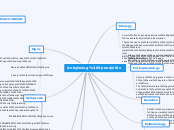Ankylosing Spondylitis
Etiology
Form of spondyloarthritis (SpA)- vertebral joint inflammation.
The causative factor is not known. Strong Association with HLA-B27, however. There is no evidence of disease-specific autoantibodies (not known).
Although many people with AS have the HLA-B27 gene, many people with the gene never get the disease.
Pathophysiology
Chronic, progressive inflammation of the axial skeleton. Joints fuse over time.
The inflammatory trigger of spondyloarthritis is not known, but when triggered, the innate immune system activates a cascade of inflammatory cytokines.
Genetics
AS is considered hereditary-- associated with the HLA-B27 gene, however, just because you have the gene does not mean that you will get the disease (most don't).
Epidemiology
-Most common between ages 20-40
M>F
Diagnostics
Imaging Studies
Radiographs of Spine & Pelvis: may show "Bamboo Spine" (fusion of vertebrae), may see syndesmophytes
Labs
Generally nonspecific: ESR & CRP elevated (50-70%)
Human Leukocyte Antigen (HLA-B27)- (90-95%)-- DOES NOT mean you have AS, though.
Explore extra-articular involvement as indicated (see "Signs" section).
Health Promotions/Patient Education
Smoking cessation, regular exercise, weight loss
If you have AS and develop painful or red eye (possible uvetitis)-- tell doctor immediately because prompt treatment greatly affects outcome.
Flare ups (severity and frequency) can vary from person to person. Prognosis also varies by person, but majority live a normal life with some behavioral modifications. Worsens with age, but prognosis is best for those who are monitored by doctors and treated earlier.
Signs
Schrober Test: increase of <5 cm upon bending over
Decreased ROM of spine
Possible fever during flares
Extraarticular Involvement: fatigue (secondary to poor sleep), IBS (50-60%), Uveitis (25-40%), Psoriasis (10%), Cardiac Dz (6-10%)-- increased risk of aortic regurgitation, Renal Dz (8%), Pulmonary Dz (2%)- can have difficulty breathing
Symptoms
ONSET: insidious, starts in the SI joint and then spreads up the spine
IMPROVEMENT WITH: exercise
NO IMPROVEMENT: with rest, worse with inactivity
Pain at night, but improves upon rising & moving
Can also involve the hips, shoulders, peripheral joints, entheses, and digits since it is a form of spondyloarthritis (but we will focus on the spine). Can also affect the tendons at their attachments to bone.
Inflammatory Back Pain normally has at least 4 out of 5 of these features: age <40, insidious onset, improvement with exercise, no improvement with rest, pain at night (improves upon rising & moving)
Treatment
GOALS: Relief of symptoms (pain, stiffness, fatigue), maintenance of fxn, prevention of complications of spinal disease, prevent flexion contractures (especially kyphosis), minimize extraspinal/extraarticular comorbidities
Medications
NSAIDS (opiods/analgesics alone are seldom effective because you have to decrease the inflammation)
Corticosteroids (short-term, during the flares only)
Biologics-- (40-50% improvement of symptoms-- LONG TERM drug). Work best if initiated before there are any radiological findings-- helps to halt the progression of the disease before it gets bad enough to show up on X-Rays.
NOT Methotrexate- No evidence of benefit.
Physical Therapy: range of motion exercises
Lifestyle Changes: sleeping on back to maintain posture
Surgery: THA (hip replacement) or Spinal Fusion
